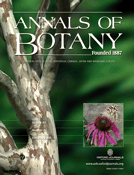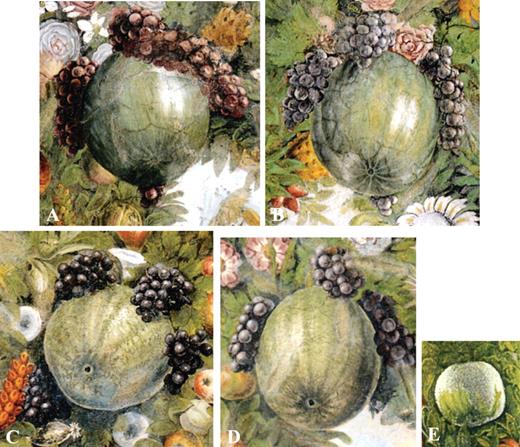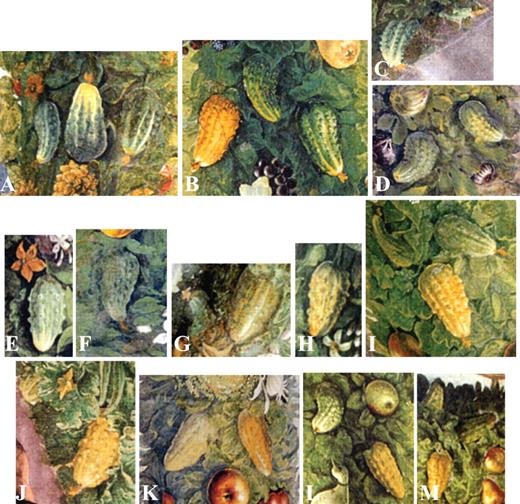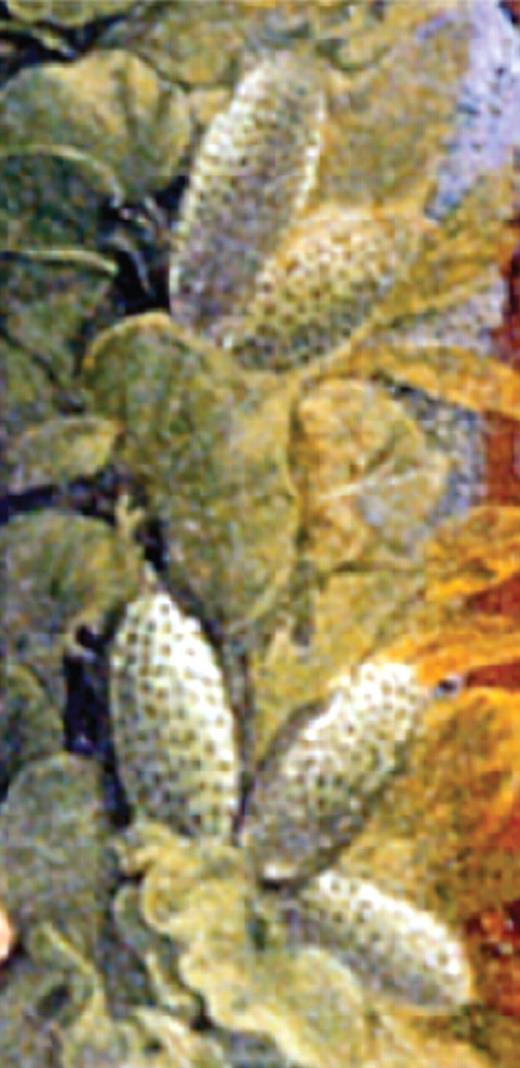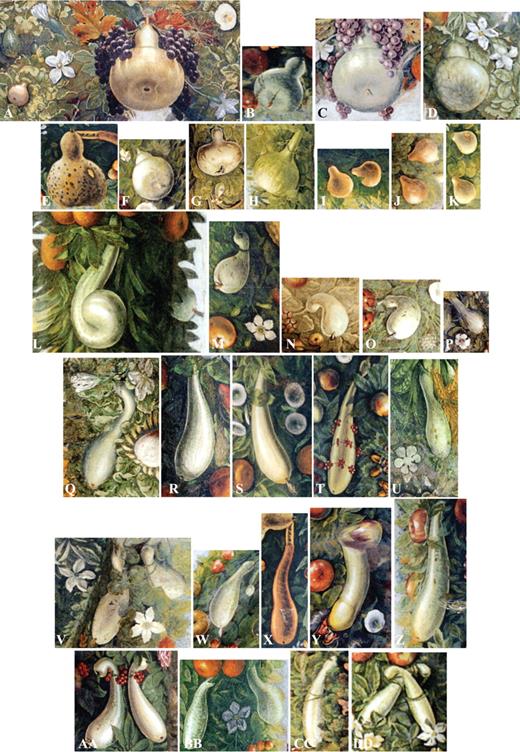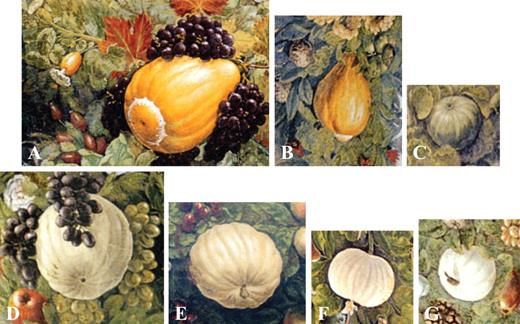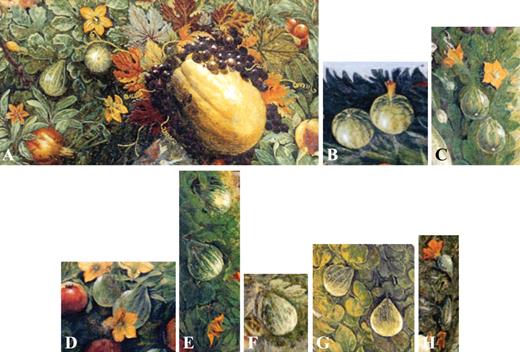-
PDF
- Split View
-
Views
-
Cite
Cite
JULES JANICK, HARRY S. PARIS, The Cucurbit Images (1515–1518) of the Villa Farnesina, Rome, Annals of Botany, Volume 97, Issue 2, February 2006, Pages 165–176, https://doi.org/10.1093/aob/mcj025
Close - Share Icon Share
Abstract
• Background The gorgeous frescoes organized by the master Renaissance painter Raphael Sanzio (1483–1520) and illustrating the heavenly adventures of Cupid and Psyche were painted between 1515 and 1518 to decorate the Roman villa (now known as the Villa Farnesina) of the wealthy Sienese banker Agostino Chigi (1466–1520). Surrounding these paintings are festoons of fruits, vegetables and flowers painted by Giovanni Martini da Udine (1487–1564), which include over 170 species of plants. A deconstruction and collation of the cucurbit images in the festoons makes it possible to evaluate the genetic diversity of cucurbits in Renaissance Italy 500 years ago.
• Findings The festoons contain six species of Old World cucurbits, Citrullus lanatus (watermelon), Cucumis melo (melon), Cucumis sativus (cucumber), Ecballium elaterium (squirting cucumber), Lagenaria siceraria (bottle gourd) and Momordica balsamina (balsam apple), and two or three species of New World cucurbits, Cucurbita maxima, C. pepo and, perhaps, C. moschata (pumpkin, squash, gourd). The images of C. maxima are the first illustrations of this species in Europe.
INTRODUCTION AND HISTORICAL CONTEXT
The sumptuous festoons painted by Giovanni Martini da Udine (1487–1564) in the Villa Farnesina contain a treasure of horticultural information consisting of thousands of images of fruits, vegetables and ornamentals from over 170 species (Caneva, 1992a,b; Cherubini, 1992). These images are a part of the decorations made for Agostino Chigi, a wealthy Sienese banker, for his new home built on the west bank of the River Tiber in Rome in 1505, and decorated between 1515 and 1518 (Gerlini, 2000). The festoons are part of the frescoes in the Loggia of Cupid and Psyche designed by Raphael Sanzio (1483–1520) and executed by his famous assistants including Giulio Romano and Giovanni Martini da Udine (Fig. 1). The villa is open to the public and a complete photographic study of the building and decorations has been recently published by Frommel (2003) as La Villa Farnesina a Roma. An identification of the plants in the festoons has been made by Giulia Caneva (1992b) in her book, Il Mondo di Cerere nella Loggia di Psiche.
The extraordinary horticultural portraits were highly praised by Georgio Vasari in 1550 who described them as ‘painted with such art that they completely resemble the living detached fruit.’ They have been considered the prototype of Western still life painting (Natures Mortes) and Giovanni da Udine can be considered a precursor to Michelangelo Merisi da Caravaggio (Janick, 2004a). The flower, fruit and vegetable images represent the voluptuousness and fertility of nature. Rather than being associated with the symbolic trappings of Christianity they are closer to the pagan traditions associated with Priapus, the god of fertility, orchards and vineyards (Morel, 1985). This is clearly evidenced by an erotic conceit whereby a gourd impregnates a fig. However, the symbolic meanings of the images of the festoons are not the subject of this paper, rather the images in the festoons will be considered as a source of historical horticultural information. Remarkably, these festoons contain the first images of Zea mays, a New World species (Caneva, 1992a; Janick and Caneva, 2005). They contain significant information concerning the dispersal of plants from the New World into Europe, as well as information on the genetic diversity of horticultural crops in the high Renaissance.
An analysis of the festoons suggests that the images represent portraits of real fruits, complete with defects and diseases. Most of the species have multiple images and their variation represents a mirror on intraspecific genetic diversity. An analysis of the images of maize (Janick and Caneva, 2005) suggests that in some cases prototypes were copied, and while some artistic license was used, by and large the portraits can be considered true representations of flowers and fruits, probably grown in the surrounding gardens (now gone) of the Villa known as the viridarium, a repository of rare plants. The images in the festoons of the Villa Farnesina inspired the painting of similar images in the Vatican (now known as Raphael's Logge) from 1517 to 1519, and there are other 16th century decorations such as at the Villa Medici in Rome and the Ville d'Este in Tivoli that show many festoons rich with horticultural subject matter.
Our objective is to focus on images of fruits of the Cucurbitaceae in the festoons of the loggia of Cupid and Psyche in the Villa Farnesina. These include watermelon, melon, cucumber, squirting cucumber, bottle gourd and balsam apple native to the Old World as well as pumpkin and gourd of the New World. We will attempt to do four things: (1) determine the correct species of the images; (2) describe variation within each species; (3) compare the images with former or contemporary artistic images; and (4) speculate on what information can be deduced from these images concerning cucurbit origin and dispersal.
THE IMAGES
The images of cucurbit fruits have been collated photographically from the festoons and associated with our attribution of species. We will indicate when these differ from the attributions of Caneva (1992b). The fruits have been oriented, in general, with the stylar (distal) end on the bottom and the relative size of the images in the festoons has been retained. Unlike the depictions of cucurbits found in Renaissance botanical herbals, very few, if any, leaves of Cucurbitaceae appear next to the fruits depicted in the festoons. It would appear that the painters had fruits and flowers brought in from the associated garden to serve as models. The leaves depicted in the festoons serve merely as a backdrop, appearing to be randomly placed without association to fruits taken from the same plant or species.
Citrullus lanatus (Thunb.) Matsum. & Nakai (watermelon) (Fig. 2)
There are five images of watermelons in the festoons. Images A–D are similar, portraying what are now called ‘icebox’ (approx. 4 kg) watermelons. They are round and medium green with narrow darker stripes. These stripes appear to be two types: faint and narrow (A and B) or more distinct and narrow (C and D). The two fruits in each type are so similar that they may be illustrations of the same fruit or perhaps fruits from a single plant. Each of these fruits is painted with a halo or crown of grapes, which is common to all of the larger cucurbits depicted in the festoons. Image E is difficult to assess because the fruit is partially covered by a white fungus; it was identified as C. melo inodorus by Caneva (1992b). This appears to us to be a watermelon because of the colour pattern of medium green with narrow darker stripes.
Citrullus lanatus (watermelon). Image E was identified as Cucumis melo var. inodorus by Caneva (1992b).
Watermelons are indigenous to tropical and semi-arid sub-tropical south-western Africa. This crop was known to the ancient Egyptians and seeds have been found in Thebes in the New Kingdom (Darby et al., 1977). The Children of Israel, wandering in the Sinai Desert, longed for the watermelons, the avattihim, of Egypt (Numbers 11: 5). Watermelons were introduced to India about 800 CE and China about 1100, and spread to south-east Asia in the 15th century, reaching Japan in the 16th century; they were introduced to Spain during the Moorish conquest of the Iberian Peninsula and then spread to the rest of Europe and by the Renaissance were widely planted in the southern parts of that continent (Rubatsky, 2001). An illustration of watermelon was painted in the late 14th century to accompany the Tacuinum Sanitatus, the Latin translation of a manuscript of the Arab physician Ibn Botlan of the 11th century. Images of watermelons found in the printed botanical herbals of the 16th century include the foliage, allowing them to be easily recognized as such by their characteristic pinnatifid leaves. These images can be found in the tomes of Fuchs (1542), Bock (1546), Dodoens (1554), Matthioli (1558), du Pinet (1561), L'Obel (1576) and many others. Depictions of watermelon fruits are common in 16th- and 17th-century European paintings and appear very similar in size, shape and rind coloration to those of the festoons. These include a watermelon fruit in the frieze of the chamber of Dominio Fiorentino painted by Jacopo Zucchi in 1585–1587 (Janick, 2004a), Caravaggio's 1603 painting Fruits and Vegetables on a Ledge (Janick, 2004b), and a painting of Pensionante del Saracceni entitled Still Life with Melons and Carafe of White Wine painted between 1615 and 1620. The festoon images by Giovanni da Udine may be the first Renaissance painting of watermelons.
Cucumis melo L. (melon) (Fig. 3)
Cucumis melo is a highly polymorphic species containing a number of distinct cultivar groups (Pitrat et al., 2000) including Cantalupensis (cantaloupe), Reticulatus (muskmelon) and Flexuosus (snake melon). Sixteen individual melons are depicted in the festoons, 11 Cantalupensis (A–K), three Reticulatus (L–N) and two Flexuosus (O and P).
Cucumis melo (melon): (A–K) Cantalupensis group; (L–N) Reticulatus group; (O and P) Flexuosus group. Note that (A)–(C) resemble ‘Cantalun’; (D)–(H) resemble ‘De Bellegarde’; (I) resembles ‘Noir des Carmes’; and (J) and (K) resemble ‘Black Rock’, both identified as Cucurbita maxima by Caneva (1992b).
The cantaloupe is named after the summer papal country house at Cantalupo (Singing Wolf) near Rome, where these melons were introduced in the 15th century. Four different types of cantaloupes appear in the festoons, all having distinct longitudinal furrows. All four resemble particular old (heirloom) cultivars, three of which were beautifully photographed and presented recently by Goldman (2002).
One type, represented by four fruits (A–C) having dark green furrows alternating with tan lobes, resembles ‘Cantalun’ (syn. ‘Charentais’), which is the leading market type of melon in France and some other countries. Three of the four fruits are split at the furrows, revealing their deep orange flesh (mesocarp).
A second type, represented by five smaller, round to slightly oblate fruits (D–H), is also distinctly furrowed but without dark green coloration in the furrows, and resembles ‘De Bellegarde’ (Goldman, 2002). One of the fruits (D) has a split at the peduncle end that reveals orange flesh.
A third type, represented by one oval fruit (I) beginning to rot at the split calyx end, is dark green splashed with yellow, revealing orange flesh, and resembles ‘Noir des Carmes’ (Goldman, 2002).
The last type, represented by two dark green, warted fruits, one large and one small (J and K) resembles the ‘Black Rock’ melon from Hooker's Drawings of Fruits, published in 1817 (Stuart, 1984). Fruits of this or a similar melon also appeared in an Italian painting from 1580, Fruttivendola (fruit seller) by Vincenzo Campi (Paris and Janick, 2005). These fruits had been classified as Cucurbita maxima ‘Marina de Chioggia’ by Caneva (1992b) but the ten lobes and furrows, the large, flat stylar scar, and the stylar end that is not depressed combine to convince us that this is a melon.
The muskmelons are named for the distinct musky odour of their mature fruits but are most easily distinguished from the cantaloupes by their reticulate (netted) rind. Of the three netted melons depicted in the festoons, two are oblong (L and M) and the other quite oblate (N), indicating that two distinct cultivars or market types are represented. Although the two oblong melons differ in external colour, one having an orange cast and the other yellow-green, this colour difference might be attributable to different stages of fruit maturity, the orange one being fully ripe or overripe. The oblate melon has a section cut out of the fruit revealing orange flesh.
The snake melons are represented by two images (O and P). Image O shows a fruit having a warty skin, an unusual characteristic for this cultivar-group.
Melons are native to tropical Africa north of the equator and are widely adventive in warmer regions of the world (Jeffrey, 2001). Apparently, they spread to China as early as 5000 years ago (Walters, 1989). Wild melons of Africa are often bitter (Mohamed and Yousif, 2004). Primitive, non-bitter melons are known from Sudan, where there are used for culinary purposes when immature (Pitrat et al., 2000; Mohamed and Yousif, 2004). The Children of Israel, in their wanderings in the Sinai wilderness, yearned for the qishu'im that they ate in Egypt (Numbers 11:5), which have been identified from linguistics and historical evidence as vegetable-type melons (Feliks, 1967). Increased length-to-width ratio of the fruit is often an indicator of culinary use of the immature cucurbit fruits as vegetables (Paris, 1989). Oblong or elongated, cucumber-like melons, assignable to the chate (adzhur) group (Pitrat et al., 2000), are also a relict crop in Italy known as carosello, and have been largely replaced there and in some other Mediterranean countries by cucumbers (Perrino et al., 1986). Such elongated, non-sweet melons apparently were familiar in parts of Europe during Roman antiquity under the guise ‘cucumbers’ (Feliks, 1968). Pliny (Bostock and Riley, 1855) described a type of ‘cucumber’ produced in Campania that had the form of a quince called melopepo; this was no doubt a melon. The very elongated ‘snake melons,’ Flexuosus group, are also used when immature as vegetables. Known in Arab countries as faqqous, they have a sour taste when mature (Burger et al., 2002).
Selection for non-bitter fruit, which is conferred by recessive bif genes, probably occurred early in the domestication of melons. Selection for non-bitterness presumably was followed by selection for non-sourness (non-acid taste) of mature fruits, which is conferred by yet another recessive gene, so. Melons of the Flexuosus group are eaten immature before acidity accumulates. However, sourness is absent from the cultivar-groups of sweet melons. Sweetness in melons accumulates just prior to fruit maturity and is conferred by a single recessive gene, suc. Selection for sweetness is considered to have occurred relatively late in melon domestication (Burger et al., 2002). As the greatest diversity of sweet melons occurs to the present day in south-western Asia (Jeffrey, 2001), sweetness was probably first selected in that region.
Apparently, the first sweet melons in Europe were introduced during the 15th century from Armenia. These were grown at Cantalupo, and then quickly spread through western Europe, Mediterranean Europe and the Americas (Jeffrey, 2001). The derived common name suggests that these first sweet melons to be cultivated in Europe were of the Cantalupensis group and indeed most of the melons illustrated in the festoons are cantaloupes. Cantaloupes also appeared in many of the early Renaissance herbals, including Fuchs (1542), Bock (1546), Dodoens (1554), Cordi (1561) depicting two different cultivars, L'Obel (1576), Camerarius (1586) and many others. Muskmelons may have been introduced to Europe somewhat later, with an illustration of what appears to be a long oval muskmelon appearing in Tabernaemontanus (1591), and in Gerard (1597) as ‘Spanish Melons’. Chabrey (1666) presented this illustration too, together with an illustration of another netted melon, named Melo Reticulatus (with the label and description misplaced on the page).
An image of a warty flexuosus appeared in the work Camerarius (1586); this image may have been derived from the estate of Conrad Gesner (1516–1565). Smooth flexuosus appeared in the herbals of L'Obel (1576), two images in Dalechamps (1587), Tabernaemontanus (1591), Gerard (1597), Dodoens (1616) and Chabrey (1666).
Cucumis sativus L. (cucumber) (Fig. 4)
Approximately 27 fruits of cucumber are illustrated, arranged in 13 clusters. All of these cucumbers resemble closely the fruits of cultivars that are commonly grown in the United States for the production of pickles. Fruits are short (length-to-width ratio approx. 3:1), with prominent large tubercules (warty protuberances on the fruit), and of a relatively light green colour when immature (Paris and Maynard, 2006). The depicted fruits are straight or slightly curved, cylindrical but tapering to the stylar end, some with distinct furrows (A–D); and their colour varies in accordance with their maturity. Some of the fruits are completely green as in F and G (immature), others are completely orange (mature) as in J–M, and others are turning from green to orange (ripening) as in I. Some of the immature fruits show whitening of the stylar end which extends as striping in the furrows (where present) along part of the length of the fruit (A–C). Many of the fruits show remnants of the corolla at their distal end (A, B, I and J). The slight differences in fruit striping and furrowing suggest the fruits were derived from several plants. This amount of variation may have been typical of that found within an open-pollinated cultivar.
Cucumbers originated in the foothills of the Himalayas of India and Nepal from where they spread to China and to the West (Jeffrey, 2001). Although considered to have been known from earliest historical times, it is difficult to determine when they reached Western civilizations because of their resemblance to long-fruited melons (Cucumis melo), with which they could have been easily confused. Indeed, cucumbers have been inferred as having been familiar in Ancient Rome. According to Pliny (Bostock and Riley, 1855), the emperor Tiberius forced these fruits in cold frames covered with mica. As the fruits were said to come in various shapes and sizes and to detach from the plant when mature, Feliks (1968) has indicated that these fruits were melons. Also, pictures of ‘cucumbers’ in mosaics of the Roman and Byzantine empires show quite long fruit, suggestive of long-fruited Cucumis melo (pp. 136 and 139 in Roberts, 2001).
The cucumber images of the Villa Farnesina closely resemble those found in 15th century paintings by Carlo Crivelli [Lochis Madonna c. 1480, Madonna and Child with four Saints, 1482, and Madonna of the Taper c. 1490; see pp. 189, 166 and 176 in Nature and Its Symbols (Impelluso, 2004)]. In the 16th century, images of cucumber plants with American pickling-type fruits are found in botanical herbals of Fuchs (1542), Bock (1546), Dodoens (1554), Mattioli (1558), L'Obel (1576) and Camerarius (1586); in Tabernaemontanus (1591), Gerard (1597) and Chabrey (1666) this type of cucumber is depicted, as well as a cucumber plant bearing small pyriform fruits which is probably an andromonoecious cultivar, labelled by Chabrey (1666) as Cucumer minor pyriformis. A pyriform cucumber was painted between 1505 and 1508 in the single-copy prayer book Grandes Heures d'Anne de Bretagne (Camus, 1894), and is reproduced in Bilimoff (2001, p. 92). Andromonoecious cucumber cultivars are few in number today, the most familiar one being ‘Lemon’.
Cucumbers are also depicted in a painting by Caravaggio (Lute Player, 1586) and an earlier painting attributed to the Master of Hartford (Still Life with Flowers, Fruits and Vegetables); and the famous Still life by the Spanish artist Juan Sanches Cotán (c. 1600). Sculpted cucumber fruits are found in the ceramics of Luca della Robbia (1399–1482) and can be found on the bronze doors of the Cathedral in the Piazza Miracoli in Pisa that date to 1601. All of these resemble the American pickling cucumber, indicating that this type of cucumber was common in Europe from during the 15th and 16th centuries, from whence it arrived in the United States. In contrast to the melons, little diversity of cucumber has been found in the festoons and in other historical records of Renaissance Europe.
Ecballium elaterium (L.) A. Rich. (squirting cucumber) (Fig. 5)
One festoon image with five fruits is identified by Caneva (1992b) as Ecballium elaterium and we agree. Squirting cucumber was occasionally cultivated in the 16th century as a medicinal plant (Jeffrey, 2001). It is rarely cultivated today except as a curiosity; it can be frequently encountered as a wild plant in Mediterranean countries. It is unusual for a wild cucurbit in that its plants have a bushy rather than a viney growth habit.
The fruits of squirting cucumber are small, approx. 2 or 3 cm long, five-furrowed, long oval, light yellow-green and stiffly hairy. Early depictions of squirting cucumber appeared in the herbals of Fuchs (1542), L'Obel (1576), Mattioli (1571), Dodoens (1578, 1616), Gerard (1597), and others.
Lagenaria siceraria (Molina) Standley (bottle gourd) (Fig. 6)
The most frequent cucurbit images in the festoons, with at least 37 fruits depicted, are those of the bottle gourd. Three distinct morphological variants of bottle gourd are depicted, large bottle-shaped, small bottle-shaped and elongate.
Lagenaria siceraria (bottle gourd): (A) bottle-shaped, large and small; (B–H) large; (I–K) small; (L–DD) elongate = ‘cocuzzi’.
The large bottle-shaped type is represented by eight fruits (A–H; note that A also shows a much smaller fruit of the same shape) which appear to be portraits of individual rather than generic fruits. Some are light grey-green (B–D, F and H) whilst others (A, E and G) are tan, the latter probably reflecting a more advanced stage of fruit maturity. Three images (A, C, and D) are associated with white flowers, typical of the genus. There are differences in shape: three (C, D and F) have a short squat neck, four (A, B, E and G) have a pinched neck, and one (H) has a thin tapering neck. Fruit B shows splitting at the stylar end, while in image E the mature yellowed fruit is covered with dark fungal spots and shows an oblong slit on the surface displaying yellow flesh.
The small bottle-shaped type is represented by seven fruits (the smaller fruit in A, and I–K with two fruits each). They are tan (A), tan-orange (I and J) or green-yellow (K), again probably reflecting differing fruit maturity.
The elongate, cocuzzi type is represented by 23 fruits (L–DD, two each in V, AA, BB and DD) with some differences in their shapes based on the thickness of the stylar end. While most of the images show slightly curved shapes, one (L) is quite contorted. Differences in shape of the depicted fruits of this type suggest that some of these images (e.g. L–P) might be hybrids between the elongate and bottle-shaped types. At least four images (M, P, U, V and DD) are associated with white flowers.
One image, the well-known phallic representation of an elongated gourd penetrating a fig (Y), is clearly a made-up conceit of Giovanni da Udine based on an imaginary cocuzza. In addition, two of the images (T and AA) show the gourds enveloped with strands of red currant berries (Ribes rubrum), a not-too-subtle erotic association of the serpentine gourd with the worship of Priapus (Morel, 1985). In the Logge Raphael in the Vatican, painted in 1517–1519, immediately after these decorations, Giovanni da Udine mischievously includes a phallic representation of Lagenaria in a border and there are others by different painters in the Villa Medici (Jocobo Zucchi) and the Villa d'Este in Tivoli (Morel, 1985; Janick,2004a).
The bottle gourd, native to Zimbabwe (Wilkins-Ellert, 2003), has been distributed in cultivation pantropically including the Americas for thousands of years (Heiser, 1979). It is known from ancient Egypt. There is paleoethnobotanical evidence that bottle gourds were distributed throughout much of the Mediterranean area 4000 years ago (Kefalidou, 2003).
Lagenaria siceraria is extremely polymorphic for fruit shape. At maturity, the fruits dry out and become tan. The thick, lignified shells have proven useful for a variety of purposes, such as vessels for carrying water, culinary utensils, floats, masks and musical instruments. The young, immature fruits of some cultivars are not bitter. The cocuzzi of Italy are long and slim, remaining tender even when achieving a length of 50 cm; at maturity they can exceed 100 cm. Cocuzzi fruits are curved if the plants are left to grow on the ground, but straight if grown on a trellis. Cocuzzi are still cultivated in Sicily and consumed in the immature state but have been replaced in many localities by cultivars of the cocozelle group of Cucurbita pepo (Paris, 2001). At the present time, Lagenaria siceraria is often used as a rootstock for grafted watermelon or melon (Lee and Oda, 2003).
The history of the bottle gourd in Europe from Roman times to the Renaissance has been reviewed by Teppner (2004). Bottle gourds are found in the Tacuinum Sanitatus of the late 14th century, in an image clearly showing flowers and bottle-shaped fruit. A bottle-shaped fruit borne on a Lagenaria siceraria plant is depicted in the Das Puch de Natur by Konrad von Megenberg, published at Augsburg in 1475 (Eisendrath, 1961). Another image of a bottle-shaped gourd appeared in the Gart der Gesundheit, published by Peter Schöeffer at Mainz, Germany in 1485 (Reed, 1942). An early colour depiction of a bottle-shaped gourd, painted between 1505 and 1508, appeared in the Grandes Heures d'Anne de Bretagne (Camus, 1894; reproduced on p. 92 in Bilimoff, 2001). The images of elongate, cocuzzi-type bottle gourds in the Villa Farnesina festoons antedate those that appeared in print.
Exactly as depicted in the festoons, in the printed botanical herbals of the mid-16th century three fruit forms of bottle gourds are depicted: large bottle-shaped, small bottle-shaped and elongate (Fuchs, 1542; Bock, 1546; Dodoens, 1554, 1616; Tabernaemontanus, 1591; Gerard, 1597, and others). There are numerous paintings and tapestries of the 16th century that include Lagenaria by artists such as Bronzini and Campi.
Momordica balsamina L. (balsam apple) (Fig. 7)
Four images of M. balsamina appear in the festoons with a total of 12 fruits. The fruits are slightly warty, with a pointed end, and some of them are red and others are orange. Balsam apple is probably native to drier areas of the palaeotropics (Jeffrey, 2001). The fruits are bitter. It is a minor crop grown in relatively dry tropical areas for vegetable or medicinal purposes. Depictions of this plant appeared in the herbals of Fuchs (1542), Dodoens (1616) and Chabrey (1666), among others, and was also described by Ray (1686). This plant does not seem to have been associated with other Cucurbitaceae by some of the Renaissance botanists, including Fuchs (1542).
Cucurbita maxima Duchesne (pumpkin) (Fig. 8)
Cucurbita maxima is appropriately named as it includes the largest fruits on earth. The giant show pumpkins, which can weigh as much as 600 kg, are included within this species together with the smaller-fruited turban gourds and various cultivars, many of which have excellent consumer quality. Three cultivars of C. maxima appear in the festoons, two of them representative of the market class of show pumpkins.
Cucurbita maxima (pumpkin): (A and B) orange show pumpkin; (C) grey pumpkin; (D–G) white show pumpkin. Caneva (1992b) classified (A) and (B) as Cucurbita moschata, (C) as Citrullus colocynthis and (D)–(G) as Cucumis melo var. inodorus.
One of the show pumpkins in the festoons is represented by two brilliant orange fruits (A and B). Image A, which also contains a flower with an orange ovary, is more aesthetically pleasing than image B because the fruit is more uniformly furrowed; it is adorned with two bunches of black grapes. Both fruits show a somewhat protruding stylar end with a circular scar.
Image C is of a grey, oblate fruit that is smaller than the orange pumpkin. Fruits of this size and colour in C. maxima are associated with high quality fruit flesh (Goldman, 2004). This fruit, identified by Caneva (1992b) as Citrullus colocynthis, has a colour rather typical of C. maxima and too grey for Citrullus. Its large, protruding stylar scar and relatively low number of longitudinal stripes make its identification as C. maxima all the more likely.
The other show pumpkins in the festoons (D–G) are represented by four white, furrowed fruits. The largest (D) is crowned with black and gold grape clusters. The clear depiction of ten longitudinal secondary furrows alternating with 10 primary furrows (D–F) render untenable the attribution of these fruits as Cucumis melo var. inodorous by Caneva (1992b). Secondary furrowing is a familiar trait among the show pumpkins of C. maxima.
Cucurbita maxima is indigenous to South America. There is no evidence that it was cultivated outside of that continent in pre-Columbian times (Merrick, 1995) and is the only cultivated species of Cucurbita that has not been commonly grown in Mexico, even to the present day (Lira Saade and Montes Hernández, 1994).
The Zucha maiore rotunda described by Cordi (1561) is perhaps an early description of Cucurbita maxima. The first image of C. maxima appearing in the tomes of European botanists apparently is the Pepo maximus Indicus compressus in L'Obel (1576), subsequently reproduced in Dalechamps (1587), Dodoens (1616), Gerarde and Johnson (1636), Bauhin (1651), Chabrey (1666), and others.
The festoon images of C. maxima antedate the heretofore earliest generally recognized image of this species by more than a half-century. Furthermore, the images in the festoons include three distinct cultivars. Such variation of the fruits of C. maxima was not documented in Europe, to our knowledge, until the latter half of the 18th century (Duchesne, 1786), over 250 years later.
Cucurbita pepo L. (gourd, pumpkin) (Fig. 9)
Cucurbita pepo is an extremely polymorphic species. Its cultigens are considered to have been derived from two separate subspecies (Decker, 1988) and have been recognized as forming 11 cultivar groups (Paris, 2001). Eight of these groups bear fruits that are used for culinary purposes: from subsp. pepo the pumpkin, cocozelle, vegetable marrow and zucchini groups; from subsp. texana (Scheele) Filov [=subsp. ovifera (L.) Decker] the scallop, acorn, crookneck and straightneck groups. The other three groups are grown mostly as ornamentals: the round, smooth-rind gourd, the warted gourd (both subsp. pepo) and the oviform gourd (subsp. texana). The festoons contain nine images which we identify as C. pepo.
Cucurbita pepo (pumpkin, gourd): (A and B) pumpkin group; (C–H) oviform and pyriform gourds. Caneva (1992b) classified (A) as Cucurbita maxima and (B)–(H) as C. pepo.
There is one large pumpkin (A) adorned by two clusters of black grapes; nearby are drawn, as if on the same vine, three yellow flowers, two in anthesis and one in bud, and two small green striped fruit. The mature fruit is oval, slightly lobed and furrowed, and mostly light orange-yellow though partly grey-green, indicating a fruit that has just barely attained ripeness. Caneva (1992b) indicated that this was C. maxima, but the colour is inconsistent with this species. Although the lobing of the fruit is reminiscent of C. moschata Duchesne, the coloration is more suggestive of the pumpkin group of C. pepo. It resembles the lobed pumpkins that appeared in an image of a plant labelled Melopepo teres of Tabernaemontanus (1591); this plant is depicted as having indented, angular leaf laminae and hence appears to be C. pepo (Paris, 2001, fig. 2.5). Cucurbita pepo pumpkins were illustrated nearly a half-century earlier, in De Historia Stirpium (Fuchs, 1542)
There is one image of two small, apparently immature fruit (B), possibly from the same plant, also of the pumpkin group of this species. These are globular, light green with darker stripes and markings and appear to be ribbed, suggestive of immature Mexican pumpkins. Ribbed pumpkins appeared in a number of Renaissance paintings and botanical works, among them the Vienna Codex of Fuchs (latest possible date 1562), the 1566 painting Markttafereel op het land by Joachim Beuckelaar, and in the work of Camerarius (1586) in an image probably derived from the estate of Conrad Gesner (and therefore latest possible date 1565) (Paris, 2001, fig. 2.6).
The festoons contain six clusters of striped, oviform to pyriform gourds (C–H). These could be representatives either of the cultivated oviform gourd group or may represent wild Texan gourds, which are quite similar phenotypically. These gourds, both those cultivated as ornamentals and the wild ones, usually have thin, white flesh that is almost always quite bitter and their representation in the festoons could only result from their decorative appeal. We identify the image, Quegourdes de Turquie, painted in the Grandes Heures d'Anne de Bretagne (Camus, 1894; reproduced on p. 92 in Bilimoff, 2001) no later than 1508, as a not altogether accurate depiction of a pyriform gourd of C. pepo. Oviform/pyriform gourds were accurately illustrated in the Vienna Codex of Fuchs, which was completed by 1562 (Paris, 2001). Another early but much more widely distributed image of these gourds first appeared as the Colocynthis pyriformis of L'Obel (1576) and copied, with or without representation of a supporting trellis, in Tabernaemontanus (1591), Gerard (1597), Dodoens (1616) and Gerarde and Johnson (1636). One of the festoon images (D) shows two of these gourds in close proximity to two large, yellow-orange staminate flowers of Cucurbita.
Cucurbita pepo is native to North America and wild plants of this species can be found growing to the present in north-eastern Mexico (Andres, 1987) and south, south-east and central USA (Decker, 1988). It is an ancient domesticate, being cultivated for 10 000 years (Smith, 1997). Nine of its cultivar groups (all but the straightneck and zucchini) appeared in European images by the close of the 16th century (Paris and Janick, 2005).
It had been thought that the first European images of C. pepo appeared in the herbals of Fuchs (1542) and Roeslin (1542), both of which contain pictures of two distinct pumpkin cultivars. The festoons indicate that oviform or pyriform gourds were early arrivals as well.
CONCLUSIONS
Many of the images of cultivated cucurbits in the festoons of the Villa Farnesina appear similar to existing market types. These types of watermelons, bottle gourds, cucumbers, melons, gourds and pumpkins appear to have been maintained over the course of the past 500 years. This is remarkable, considering the tendency of cucurbit cultivars belonging to the same species to cross with one another, thereby mutually diluting their distinguishing characteristics.
The diversity within the different cucurbit species depicted in the festoons is variable. Among the Old World cucurbits, watermelon and cucumber appear to have minimal variation. Three types of bottle gourds are evident. Much wider variation is evident among the melons. Remarkably, the festoons indicate substantial variation in New World cucurbits (Cucurbita maxima and C. pepo), indicating that various types were introduced in the short interval between the first voyages of Columbus and the date these festoons were painted.
The festoon images of cucumber, bottle gourd, melon and watermelon are not the earliest-known European depictions of these Old World cucurbits. Although these species were widely grown in Asia and Africa for many centuries prior to their illustration in the festoons, there are few earlier European images of them and these are usually of only one or two fruit types. These fruit types are also depicted in the festoons. The festoons document the presence of a wide range of sweet-melon (cantaloupe and muskmelon) cultivars in Europe within a century of their introduction from south-western Asia, and these images appear to be the first European paintings of these melons.
The festoon images of Cucurbita maxima (pumpkin) at the Villa Farnesina appear to be the earliest known European images of this South American species. The image published in the botanical herbal of L'Obel in 1576 had heretofore been considered the earliest European image of this species. Thus the festoon images reduce the time for the first appearance of a European image of this species by nearly 60 years.
Pumpkins of the North American species, Cucurbita pepo, were depicted in Fuchs' herbal of 1542 and pyriform gourds of this species were depicted in L'Obel's herbal of 1576. Pumpkins and pyriform gourds can also be found in Fuchs' Vienna Codex, completed in 1562. The images of C. pepo fruits in the festoons at the Villa Farnesina precede these by decades. Although not highly accurate, the image of a pyriform gourd in the Grandes Heures d'Anne de Bretagne (Camus, 1894; Bilimoff, 2001), is probably the first European image of Cucurbita pepo and indeed of the genus Cucurbita, and a decade before the festoons of the Villa Farnesina. It is noteworthy, too, that the festoons appear to contain another New World plant, Phaseolus vulgaris (haricot bean), that has also been identified in the paintings of the Grandes Heures (Camus, 1894; Zeven, 1997; Bilimoff, 2001).
Who introduced the New World cucurbits illustrated in the festoons into Italy and the rest of Europe? Cucurbita maxima is native to South America but is generally better adapted to warm temperate regions than to the tropical climate of lowland Brazil. Cucurbita pepo is native to North America and has been observed growing wild over an extensive area ranging from north-eastern Mexico north to the central Mississippi Valley and into the south-eastern USA and its pre-Columbian distribution may have been considerably greater (Heiser, 1979; Decker-Walters et al., 1993; Petersen and Sidell, 1996; Sanjur et al., 2002). The oviform/pyriform gourds of this species grow wild along the Gulf Coast of the USA, and ribbed pumpkins are cultivated in much of Mexico. However, just as maize was found growing all over the New World at the time of the encounter between Columbus and America, it is reasonable to assume that Cucurbita species were also widely cultivated. Thus, the introduction of these species could have been carried out by any number of Spanish or Portuguese explorers including Columbus. Peter Martyr D'Anghera, Italian teacher to the court of Isabel and Ferdinand, chronicled the early voyages of Columbus (MacNutt, 1912). With the return of 12 of the 17 of the Grand Fleet in the second voyage in 1494, he sent ‘all kinds of seeds’ (maize included) to Cardinal Asconio Sforza, according to a letter dated 3 May 1494. From 1492 to 1515 there were literally scores of expeditions and hundreds of ships that swarmed the Caribbean Sea; in 1506 alone, for example, 23 Spanish ships left for the West Indies and 12 returned (Morison, 1974).
The presence of Cucurbita maxima and C. pepo on the ceiling of the logge of the Farnesina and the presence of C. pepo in the Grandes Heures d'Anne de Bretagne (Bilimoff, 2001, p. 92) suggest extremely rapid diffusion of New World plants. These could have been obtained as fruits or seeds through a number of sources including the returning ships from the second voyage of Columbus to the great number of Spanish and Portuguese expeditions to the Americas. Diffusion could conceivably have occurred either through official channels or by way of returning sailors from various expeditions who could have easily carried seed in their pockets.
We thank Anna Whipkey for assistance with the figures.
LITERATURE CITED
Andres TC.
Bilimoff M.
Burger Y, Saar U, Katzir N, Paris HS, Yeselon Y, Levin I, Schaffer AA.
Camus G.
Caneva G.
Cherubini G.
Cordi V.
Darby WJ, Ghalioungui P, Grivetti L.
Decker DS.
Decker-Walters DS, Walters TW, Cowan CW, Smith BD.
Eisendrath ER.
Feliks J.
Feliks J.
Frommel CL.
Gerarde J, Johnson T.
Gerlini E.
Janick J.
Jeffrey C.
Kefalidou E.
Lee J-M, Oda M.
Lira Saade R, Montes Hernández S.
MacNutt FA. (transl.).
Mattioli PA.
Merrick LC.
Mohamed ETI, Yousif MT.
Morel P.
Morison SE.
Paris HS.
Paris HS.
Paris HS, Janick J.
Paris HS, Maynard DN.
Perrino P, Hammer K, Hanelt P.
Petersen JB, Sidell NA.
Pitrat M, Hanelt P, Hammer K.
Rubatsky VE.
Sanjur OI, Piperno DR, Andres TC, Wessel-Beaver L.
Smith BD.
Stuart DC.
Teppner H.
Walters TW.
Wilkins-Ellert M.
Author notes
1Department of Horticulture and Landscape Architecture, Purdue University, 625 Agriculture Mall Drive, West Lafayette, IN 47907-2010, USA and 2Department of Vegetable Crops and Plant Genetics, Agricultural Research Organization, Newe Ya'ar Research Center, PO Box 1021, Ramat Yishay 30-095, Israel


